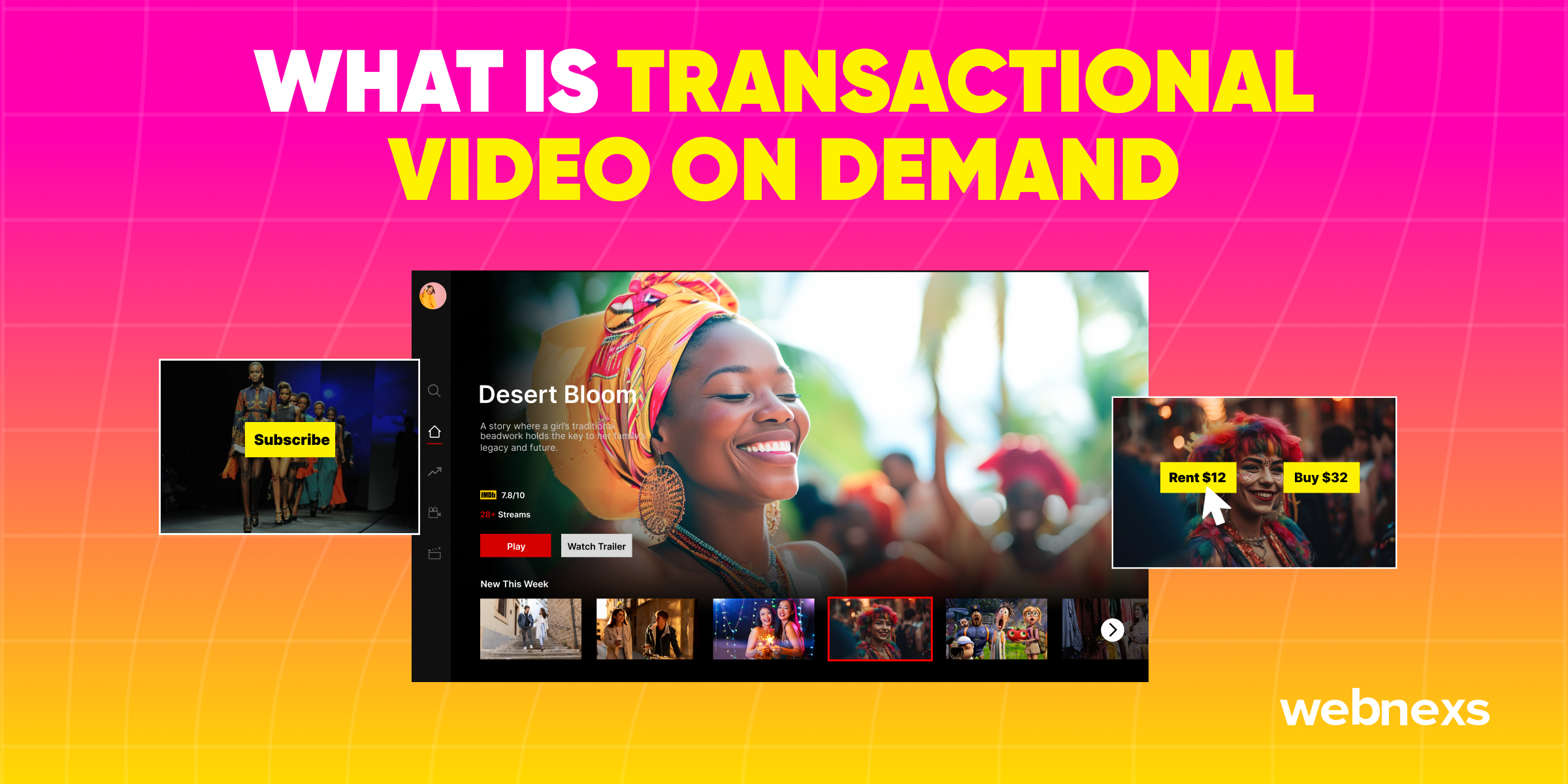Want to Monetize your video on TVOD platform? Request Demo
Transactional video-on-demand (TVOD) is a model where viewers can access a video or series of videos by paying for that particular video content. Viewers can buy the video content permanently and can also download it or else they can access it for a particular period on a rental basis. It involves getting content at a specific price point, especially for premium releases.
“Make your on-demand business a greater revenue path generating vehicle for streaming videos by adopting services”.
Key takeaways
- TVOD is a pay-per-view content based model.
- It includes 3 types, namely Electronic Sell-Through (EST), Download to Rent (DTR), and Pay-Per-View (PPV).
- Key benefits include higher revenue potential, flexibility and accessibility to exclusive content.
- Key issues exist but strategies are available to overcome them and run a thriving TVOD platform.
- There is huge potential for the TVOD market to grow, given the resource gap in the economy.
- Considering hybrid models can further increase revenue potential and customer base.
- The right quality content and pricing structure will create a successful TVOD platform.
Types Of TVOD
1. Electronic Sell-Through (EST):
The TVOD platform allows users to purchase a video for a one-time payment, granting them lifetime access to the content. Users can choose to download or stream the video without any time-frame restrictions, putting the decision entirely in their hands.
To specify the working of this type, we can say that the video is offered for downloading in a specific format for offline viewing, and for online viewing, the streaming platform gives access to a transactional video-on-demand platform.
2. Download to Rent (DTR):
It enables the users to download the video content on a rent basis for a limited time-frame. The offline viewing option is also offered for a limited duration, typically 24-48 hours. Once the time elapses, the content becomes unavailable for access and viewing on the transactional OTT platform.
The flexibility lies in not requiring internet connectivity as the content can be downloaded for an uninterrupted experience during unstable network conditions. A prime example is Google Play Movies that offers rental video content available for 24-48 hours.
3. Pay-Per-View (PPV):
Again, it works based on paying for individual pieces of video content but often for viewing live streaming events such as concerts, sports, or new movie releases. The access is restricted to only when the events occur in real time or for a few days or a week, allowing users to watch multiple times during that period on TVOD services.
It often charges higher for premium content that is exclusive which is streamed in high quality. Some platforms also offer interactive features such as live chats, additional content or others to enhance user experience. Events like WrestleMania and UFC events are available as PPV events on the TVOD platform.
Now that we are on the same page with the types, we will now look into the additional concepts that coexist with TVOD such as SVOD, AVOD, PVOD and FVOD. Together these are classified under monetization models of VOD.
1. Subscription Video on Demand (SVOD)
Users gain access to a library of video content for a recurring subscription fee that could be based on specific intervals ranging from monthly, quarterly, or yearly. This provides flexibility to choose the most preferred option based on preferences on a transactional OTT platform.
The access is withdrawn immediately when the time elapses, but options are provided to auto-renew the subscription, further enhancing convenience to the users. Notable examples include Netflix, Amazon Prime Video, and Hulu, which provide a combination of licensed and original content. Each platform differentiates itself by offering unique programs on TVOD platforms.
2. Advertising Video on Demand (AVOD)
As the name suggests, it offers content for free in return for viewing advertisements that are integrated into the video content. Advertisers pay to display their ads to viewers, and revenue is generated through them from TVOD services.
One thing to note is that the content is not offered for free, but viewers pay with their time spent on watching ads. YouTube and Tubi balance viewer satisfaction, ad frequency, and length to ensure viewers are retained and ad revenue is maximized on the TVOD platform.
3. Premium Video on Demand (PVOD)
On the higher end of the spectrum, premium video content is offered for a higher one-time payment. The significance of this model lies in the exclusivity of content such as celebrity interviews and early access to hot and hyped content on the TVOD platform.
The content is offered in two ways, either it can be accessed by renting or purchasing the content which depends on the particular platform’s decision. Apple TV+ and Amazon Prime Video are popular examples of transactional OTT platforms.
4. Freemium Video on Demand (FVOD)
This is a hybrid model that combines free and premium offerings. Users are allowed to access basic content for free, while premium features or content are restricted by paid access. To offer content for free, ads are inserted, while premium features include ad-free viewing or others on a transactional OTT platform.
This model aims to allow free access and encourage users to upgrade to a paid version. Platforms like YouTube and Crunchyroll have adopted this model successfully as it caters to individuals seeking control over their viewing experience.
Visit Here: How to start a VOD streaming platform and its advantages?
Benefits of “TVOD” platforms:
1. Flexibility:
It is also called a Pay-as-You-Go model where the users hold complete control of their viewing experiences by only paying for content they want to watch and not for the entire library of content. All of this without a regular subscription plan that is ongoing. It offers control in spending as well, which enhances user satisfaction on a transactional OTT platform.
2. High revenue potential
Higher revenue comes in the form of offering exclusive content for a higher rate, which credits the type of content streamed. Usually, these are one-time events such as celebrity events, sports, concerts, and movie releases. This model has become a success as there are users who are hardcore fans and followers of many stars and sports on a transactional video-on-demand platform.
3. Exclusive content
Content out of normal reach sells more as it holds huge value. Early access to content creates hype and increases the demand. As a result, a vast number of crowds get access to content that otherwise would be out of reach on a TVOD platform.
4. Rental option
This model provides an added layer of flexibility to the users by offering the content on a rental basis where the access to content is limited to the live stream, a few days or a week. Users who do not wish to own the content can opt for this TVOD model.
5. Better consumer experience
An uninterrupted viewing experience can be gained as the model is ad-free. Additionally, premium content can be viewed in high quality, like HD or 4K. These enhance the overall viewing experience and satisfaction on a TVOD platform.
6. Targeted audience appeal
It specifically caters to a niche audience who value the quality of content rather than quantity. Moreover, this is a flexible option for those not habituated to regular video consumption but those who occasionally prefer to watch exclusive content on a transactional OTT platform.
7. Diversified revenue stream for platforms
As a platform owner, you can combine transactional video-on-demand (TVOD) along with other models to further allow for flexibility in viewing content to your users. This diversifies your offerings and caters to a larger audience while increasing the streams of revenue generation and the potential.
8. Transparent cost structure
Budgeting becomes an easier task for the users on a TVOD platform as they can specifically curate their library of video content and pay only for individual pieces of content as per their preference. Pricing is transparent compared to a tiered subscription structure, where hidden fees can be charged.
9. Global reach
Content relevance as per the regions sells more on a transactional OTT platform. When region-centric video content is offered it resonates with the audience and draws them to the platform in expectation of viewing more similar content. This strategy can be used to reach international markets and scale up the platform.
10. Lower consumer churn
Due to its pricing model, the TVOD platform puts no pressure on users to renew in the form of a recurring fee. This reduces the chances of canceling services and churn rates. Over time, a larger customer base can be formed. Since the nature of the content offered is new each time, users are likely to become loyal customers and share through word-of-mouth.
11. Content creator advantages
Content creators can earn without relying on ads or subscription models. This direct flow of income encourages them to create additional exclusive content specifically for the transactional video-on-demand (TVOD) model. The pricing can be determined based on value, quality and market demand which renders a reasonable pricing that justifies the work behind.
12. Minimal commitment for new users
Over the years, the penetration of VOD platforms has been heavy. With this surge, many platforms are available that distract and confuse users when picking the one that most resonates with their preferences. With this scenario, the transactional video-on-demand (TVOD) offers a risk-free option to try without risking to pay for content they would not otherwise prefer. It allows them to explore their preferences without much hindrance.
13. Supports diverse content genres
In order to cover a wider audience that has diversified preferences and interests in content genres, this TVOD model offers variety. From widely available content to exclusive platform-specific content, everything is offered in a single model.
Strategies for “TVOD” services:
TVOD services are key to making a clear plan for grabbing more people’s attention in publishing new ways of content. Based on video content (i.e movies, shows, sports, astrology, price points can be changed. It encourages people to show interest in particular content and gets regular updates. It maintains a unique way to facilitate viewers to overcome their television rivals.
Read More: How Pay-per-view concepts are applied in TVOD platforms to publish your media contents?
Challenges in TVOD model
1. Limited audience conversion
When compared to the subscription-based model, converting users to become pay-per-content users on this TVOD platform can be difficult, especially when users prefer the all-you-can-watch option and when there are plenty of platforms available in the market offering similar services.
Solution
- Content previews or free trials can be offered to make the TVOD platform more appealing to convince the users.
- Discounts offered can surely lure potential customers to purchase.
- Highlight and widen awareness of the arrival of exclusive and newly released content.
2. Content licensing costs
While exclusivity makes the TVOD platform attractive, it is expensive to purchase such content and impacts profitability. A balance must be struck between offering and procuring content to ensure the long-term sustainability of the platform.
Solution
- The revenue-sharing deals can be negotiated with the content creators to reduce upfront costs on a TVOD platform.
- Original production of exclusive content eliminates content acquisition costs.
- Gain useful insights into high-demand content genres and invest in procuring such content.
3. Low customer retention
Long-term commitment to the TVOD platform is difficult, as the ongoing user engagement element is missing, unlike in a subscription-based model. This creates a gap in consumption and reduces the possibilities of developing a rapport with the users to retain them over long-term.
Solution
- Repeat purchases can be ensured by offering loyalty programs and discounts.
- Retargeting can be achieved via email marketing.
- AI powered personalized recommendations can be offered to connect the user to the platform.
4. Content piracy
In the digital era, content piracy is a threat not only to VOD platforms but in other industries as well. But within the VOD segment, TVOD-based platforms are at an even higher risk. This is due to the exclusive nature of content being offered.
Solution
- Digital Rights Management (DRM) systems can be established to secure content.
- Deploy monitoring tools to track unauthorized distribution of content.
Growth of TVOD
As the consumer preferences and technological advancements continue to evolve, the future of the TVOD model is promising. This is supported by the fact that the global TVOD market for the current year holds approximately USD 14.07 billion in value, while the projected estimate is expected to reach USD 270.04 billion by 2031. This converts to a CAGR of 13.4% from 2024 to 2031. This whopping number indicates the aggressive growth that is to be undertaken by TVOD to drive excellent growth potential for platforms seeking to invest in this model.
Potential regions for this model to thrive include Southeast Asia, Latin America, and parts of Africa which are emerging markets that provide a significant opportunity for TVOD platforms. This is attributed to the economic state where the limited disposable income makes subscription-based models less appealing. Moreover, pay-per-view content allows users to only shell out money for the content they prefer, which acts as a low-barrier entry encouraging them to purchase without committing to the platform.
Other considerations to capitalize on ideas and grow are to integrate transactional video-on -demand (TVOD) with SVOD or AVOD, where a hybrid model diversifies risk and increases the revenue generating potential of the platform. The viability gained by combining these models offers flexibility. As the streaming infrastructure improves globally, TVODs will gain more prominence by being able to deliver improved quality of content that can boost user satisfaction and increase retention rates.
The key function for “TVOD” services:
- An easy way of getting revenue opportunities.
- Encourage companies to commence in this field.
- No regulations from governments so far.
- Accurate charges are collected based on contents.
- Creative and innovative contents are available.
CONCLUSION:
To form a new on-demand solution, Transactional Video on Demand (TVOD) is the best way of generating a higher revenue share. Modern technology is getting updated more and so these platforms paved way for another level of experience for users to watch content on their move.
Given the CAGR prediction for the next 7 years, we can rightly arrive at a conclusion by stating that the growth of this model is undeniable. New platform entrants have a strategic opportunity to offer compelling video content that can create a huge customer base when it is paired with the right pricing strategy. Striking a balance between high quality content and pricing will appeal to a larger crowd and drive the overall visibility and growth of the transactional OTT platform.



5 Responses
Happy to read this blog as i got clear understanding of TVOD Platforms
In Tvod Model, EST Can be best pick
TVOD Model is one of best monetization model for VOD platforms
Thanks for sharing
Clear expalnation Of Tvod Platforms
Way you define about TVOD Platform was simple and good thanks for sharing your thoughts